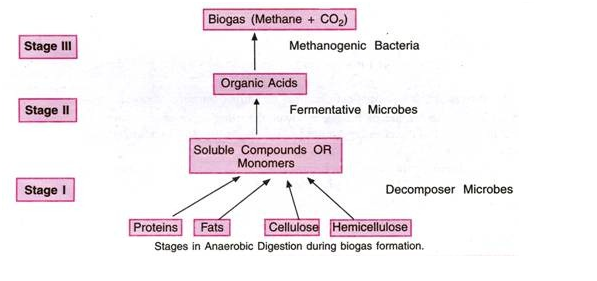ADVERTISEMENTS:
Essay on Biogas!
Biogas is a methane rich fuel gas produced by anaerobic breakdown or digestion of biomass with the help of methanogenic bacteria.
Biogas is made up of methane (50-70%), carbon dixide (30-40%) with traces of nitrogen, hydrogen sulphide and hydrogen. 50% of the combustible energy present in the organic waste can be changed into methane gas.
ADVERTISEMENTS:
The energy realised from biogas depends upon the proportion of methane present in it.
The calorific value of biogas is 23-28 MJ/m3. The effluent and residue left after the fermentative generation of biogas is rich in minerals, lignin and a part of cellulose. It is an ideal manure. Biogas or gobar gas generation has been taken up in India on a large scale.
Already, there are over a million individual and several thousand community biogas plants operating in the country. The technology was developed by the collaboration of Khadi and Village Industries Commission (KVIC) and Indian Agricultural Research Institute (IARI).
Biogas generation is a three-stage anaerobic digestion of animal and other organic wastes. The latter consist of lignin, cellulose, hemicellulose, lipids and proteins. Lignin cannot be broken down under anaerobic conditions. Cellulose digestion is slower than that of other substances.
In the first stage of anaerobic digestion, facultative anaerobic decomposer microbes bring about enzymatic breakdown of complex organic compounds into simpler and soluble compounds often called ‘monomers’. For this, the decomposer microbes secrete celluloses, proteases and lipases (cellulolytic, proteolytic and lipolytic enzymes).
In the second stage, the simple soluble compounds of microbial digestion or monomers are acted upon by fermentation causing microbes. The latter change the monomers into organic acids. Organic acids, especially acetic acid, are acted upon by methanogenic bacteria in the third or final stage. The methane bacteria convert organic acids as well as carbon dioxide into methane. The biogas thus formed is stored in tanks for supply.
Advantages:
Using organic wastes first for biogas generation has several advantages over their direct use as fuel or fertilizer (Fig. 10.8).
(1) It provides both energy and manure.
(2) Biogas is a storable form of energy which can be used more efficiently and economically.
(3) Biogas has wider applications than the direct burning of organic wastes.
(4) The energy value of biogas is lower than that of organic matter but due to more efficient handling, the net energy output is roughly equal to the output in direct burning of organic wastes.
ADVERTISEMENTS:
(5) It minimises the chances of spread of faecal pathogens. Sanitation and health are, therefore, improved. This is not possible in other cases.
(6) The fertilizer value of the manure produced in biogas plants is similar to that of manure formed directly from organic wastes.
(7) Spread of plant pathogens with the help of crop residue is checked.
(8) Biogas use does not add to pollution.



